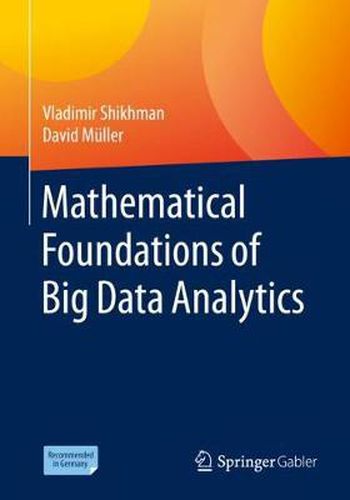Readings Newsletter
Become a Readings Member to make your shopping experience even easier.
Sign in or sign up for free!
You’re not far away from qualifying for FREE standard shipping within Australia
You’ve qualified for FREE standard shipping within Australia
The cart is loading…






This title is printed to order. This book may have been self-published. If so, we cannot guarantee the quality of the content. In the main most books will have gone through the editing process however some may not. We therefore suggest that you be aware of this before ordering this book. If in doubt check either the author or publisher’s details as we are unable to accept any returns unless they are faulty. Please contact us if you have any questions.
In this textbook, basic mathematical models used in Big Data Analytics are presented and application-oriented references to relevant practical issues are made. Necessary mathematical tools are examined and applied to current problems of data analysis, such as brand loyalty, portfolio selection, credit investigation, quality control, product clustering, asset pricing etc. - mainly in an economic context. In addition, we discuss interdisciplinary applications to biology, linguistics, sociology, electrical engineering, computer science and artificial intelligence. For the models, we make use of a wide range of mathematics - from basic disciplines of numerical linear algebra, statistics and optimization to more specialized game, graph and even complexity theories. By doing so, we cover all relevant techniques commonly used in Big Data Analytics.Each chapter starts with a concrete practical problem whose primary aim is to motivate the study of a particular Big Data Analytics technique. Next, mathematical results follow - including important definitions, auxiliary statements and conclusions arising. Case-studies help to deepen the acquired knowledge by applying it in an interdisciplinary context. Exercises serve to improve understanding of the underlying theory. Complete solutions for exercises can be consulted by the interested reader at the end of the textbook; for some which have to be solved numerically, we provide descriptions of algorithms in Python code as supplementary material.This textbook has been recommended and developed for university courses in Germany, Austria and Switzerland.
$9.00 standard shipping within Australia
FREE standard shipping within Australia for orders over $100.00
Express & International shipping calculated at checkout
This title is printed to order. This book may have been self-published. If so, we cannot guarantee the quality of the content. In the main most books will have gone through the editing process however some may not. We therefore suggest that you be aware of this before ordering this book. If in doubt check either the author or publisher’s details as we are unable to accept any returns unless they are faulty. Please contact us if you have any questions.
In this textbook, basic mathematical models used in Big Data Analytics are presented and application-oriented references to relevant practical issues are made. Necessary mathematical tools are examined and applied to current problems of data analysis, such as brand loyalty, portfolio selection, credit investigation, quality control, product clustering, asset pricing etc. - mainly in an economic context. In addition, we discuss interdisciplinary applications to biology, linguistics, sociology, electrical engineering, computer science and artificial intelligence. For the models, we make use of a wide range of mathematics - from basic disciplines of numerical linear algebra, statistics and optimization to more specialized game, graph and even complexity theories. By doing so, we cover all relevant techniques commonly used in Big Data Analytics.Each chapter starts with a concrete practical problem whose primary aim is to motivate the study of a particular Big Data Analytics technique. Next, mathematical results follow - including important definitions, auxiliary statements and conclusions arising. Case-studies help to deepen the acquired knowledge by applying it in an interdisciplinary context. Exercises serve to improve understanding of the underlying theory. Complete solutions for exercises can be consulted by the interested reader at the end of the textbook; for some which have to be solved numerically, we provide descriptions of algorithms in Python code as supplementary material.This textbook has been recommended and developed for university courses in Germany, Austria and Switzerland.